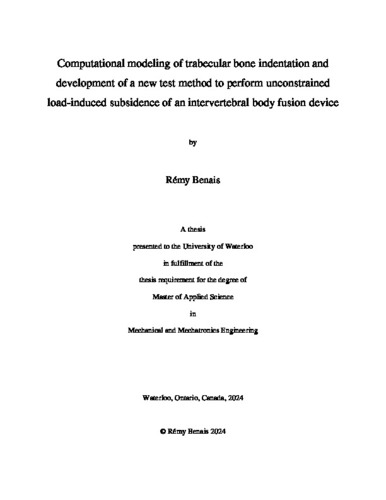| dc.description.abstract | Intervertebral body fusion devices (“interbody cages”) used in spinal surgeries are susceptible to axial and/or rotational subsidence into the underlying trabecular bone of the spinal vertebrae. Despite the variety of pre-clinical testing methods and previously developed detailed computational models, the ability to pre-operatively predict implant subsidence remains limited. Current state-of-the-art computational models have issues due to the size and complexity of existing subject-specific, image-based models. In contrast, experimental testing standards, such as ASTM F2267, overly simplify the loading and bone materials. The goals of this thesis were: 1) to develop a simplified finite element (FE) model for trabecular bone indentation towards pre-clinical implant subsidence prediction, and 2) to develop and evaluate a novel test method to perform unconstrained load-induced implant subsidence.
The first study involved explicit FE simulations created in LS-Dyna (Version 12.1, LST, Livermore, California, USA) using smoothed particle hydrodynamics (SPH) elements to model confined indentation of human trabecular bone, using different indenter-tip geometries. A generalized continuum-level approach with an isotropic crushable foam (CF) material model was developed to represent trabecular bone. Five such FE models were generated calibrated to cadaveric specimens spanning a range of bone mineral densities (BMD). Additionally, an alternative model configuration was developed that included consideration of bone marrow, with bone and marrow material parameters assigned to SPH elements randomly, owing to the quasi-stochastic nature of trabecular bone tissue microstructure. Analysis of the FE models using correlation and analysis software found a good match to the behaviour previously observed experimentally, accurately capturing the shape of the force-displacement curves as well as bone densification patterns seen in clinical imaging. Inclusion of marrow elements offered improved response prediction of the flat-tip indenter tests.
In a second study, a new force-control (FC) experimental testing method was developed for conducting unconstrained load-induced implant subsidence. This new method was compared to the ASTM F2267 method, which uses a lubricated ball-and-socket joint (BSJ), using the VIVO joint motion simulator (AMTI, Massachusetts, USA) to apply unconstrained loading up to 4kN. Subsidence testing was performed on two different polyurethane (PU) foams densities (rigid 20 and 30 PCF) sandwiched together providing a boundary interface to induce implant rotation into the less dense foam. Unconstrained axial compression up to 4kN yielded, on average, 2.51 mm (SD = 0.38) versus 4.68 mm (SD = 0.57) of axial subsidence for BSJ setup compared to the FC setup, respectively. The BSJ setup had an average implant rotation of 2.77° (SD = 0.50), in contrast to the FC setup, with an average of 17.97° (SD = 0.89). The results were further compared to computational results using a SPH FE model mimicking the experiment.
Ultimately, the presented work demonstrates the ability of a generalizable continuum-level SPH approach to capture bone variability using clinical bone imaging metrics without needing detailed image-based geometries, a significant step towards simplified pre-clinical modeling of implant subsidence prediction. Further, the development of new experimental testing methods for unconstrained load-induced subsidence demonstrates the potential improvement for implant subsidence testing relative to devices conforming to ASTM F2267. | en |

